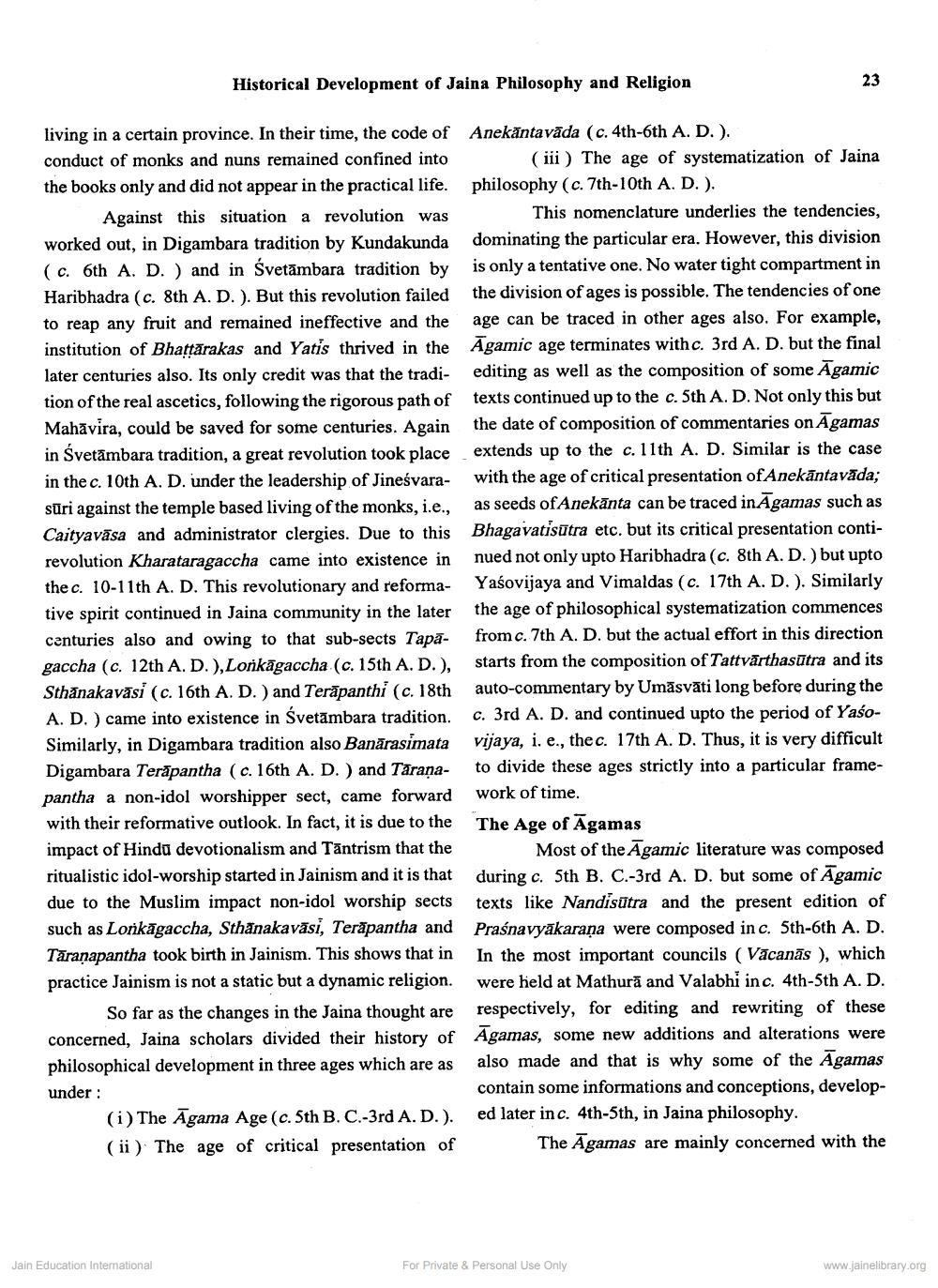Book Title: Historical Development of Jaina Philosophy and Religious Author(s): Sagarmal Jain Publisher: Z_Shwetambar_Sthanakvasi_Jain_Sabha_Hirak_Jayanti_Granth_012052.pdf View full book textPage 2
________________ Historical Development of Jaina Philosophy and Religion living in a certain province. In their time, the code of conduct of monks and nuns remained confined into the books only and did not appear in the practical life. Against this situation a revolution was worked out, in Digambara tradition by Kundakunda (c. 6th A. D. ) and in svetāmbara tradition by Haribhadra (c. 8th A. D. ). But this revolution failed to reap any fruit and remained ineffective and the institution of Bhattārakas and Yatis thrived in the later centuries also. Its only credit was that the tradi- tion of the real ascetics, following the rigorous path of Mahāvira, could be saved for some centuries. Again in Svetāmbara tradition, a great revolution took place in the c. 10th A. D. under the leadership of Jineśvara- sūri against the temple based living of the monks, i.e., Caityavāsa and administrator clergies. Due to this revolution Kharataragaccha came into existence in the c. 10-11th A. D. This revolutionary and reforma- tive spirit continued in Jaina community in the later centuries also and owing to that sub-sects Tapā- gaccha (c. 12th A. D. ), Lorikāgaccha (c. 15th A.D.), Sthanakavāsi (c. 16th A. D.) and Terāpanthi (c. 18th A. D. ) came into existence in Svetāmbara tradition. Similarly, in Digambara tradition also Banārasimata Digambara Terāpantha (c. 16th A. D. ) and Tarana- pantha a non-idol worshipper sect, came forward with their reformative outlook. In fact, it is due to the impact of Hindu devotionalism and Tantrism that the ritualistic idol-worship started in Jainism and it is that due to the Muslim impact non-idol worship sects such as Lorkāgaccha, Sthanakavāsi, Teräpantha and Taranapantha took birth in Jainism. This shows that in practice Jainism is not a static but a dynamic religion. So far as the changes in the Jaina thought are concerned, Jaina scholars divided their history of philosophical development in three ages which are as under: (i) The Agama Age (c. Sth B. C.-3rd A.D.). (ii) The age of critical presentation of Anekāntavāda (c. 4th-6th A. D.). (iii) The age of systematization of Jaina philosophy (c. 7th-10th A. D.). This nomenclature underlies the tendencies, dominating the particular era. However, this division is only a tentative one. No water tight compartment in the division of ages is possible. The tendencies of one age can be traced in other ages also. For example, Agamic age terminates with c. 3rd A. D. but the final editing as well as the composition of some Āgamic texts continued up to the c. 5th A. D. Not only this but the date of composition of commentaries on Āgamas extends up to the c. 11th A. D. Similar is the case with the age of critical presentation of Anekāntavāda; as seeds of Anekānta can be traced in Āgamas such as Bhagavatisūtra etc. but its critical presentation continued not only upto Haribhadra (c. 8th A. D.) but upto Yaśovijaya and Vimaldas (c. 17th A. D.). Similarly the age of philosophical systematization commences from c. 7th A. D. but the actual effort in this direction starts from the composition of Tattvārthasūtra and its auto-commentary by Umāsvāti long before during the c. 3rd A. D. and continued upto the period of Yaśovijaya, i. e., the c. 17th A. D. Thus, it is very difficult to divide these ages strictly into a particular framework of time. The Age of Āgamas Most of the Agamic literature was composed during c. 5th B. C.-3rd A. D. but some of Āgamic texts like Nandisutra and the present edition of Praśnavyākarana were composed in c. 5th-6th A. D. In the most important councils (Vacanās ), which were held at Mathurā and Valabhi inc. 4th-5th A. D. respectively, for editing and rewriting of these Agamas, some new additions and alterations were also made and that is why some of the Agamas contain some informations and conceptions, developed later in c. 4th-5th, in Jaina philosophy. The Āgamas are mainly concerned with the Jain Education Interational For Private & Personal Use Only www.jainelibrary.orgPage Navigation
1 2 3 4 5 6 7 8 9 10 11 12 13
